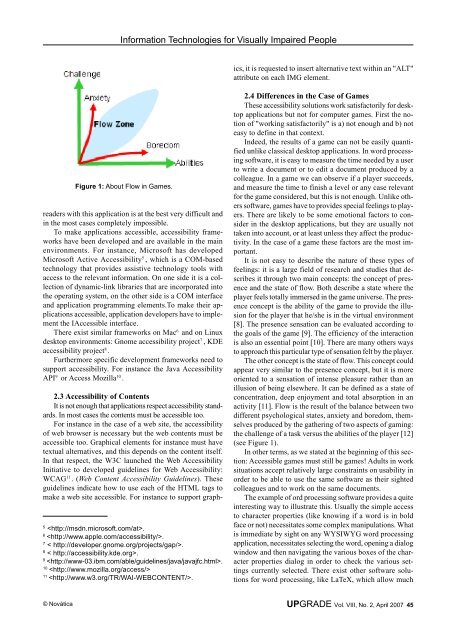Download full issue (PDF 2.1MB) - Council of European ...
Download full issue (PDF 2.1MB) - Council of European ...
Download full issue (PDF 2.1MB) - Council of European ...
You also want an ePaper? Increase the reach of your titles
YUMPU automatically turns print PDFs into web optimized ePapers that Google loves.
© Novática<br />
Information Technologies for Visually Impaired People<br />
Figure 1: About Flow in Games.<br />
readers with this application is at the best very difficult and<br />
in the most cases completely impossible.<br />
To make applications accessible, accessibility frameworks<br />
have been developed and are available in the main<br />
environments. For instance, Micros<strong>of</strong>t has developed<br />
Micros<strong>of</strong>t Active Accessibility 5 , which is a COM-based<br />
technology that provides assistive technology tools with<br />
access to the relevant information. On one side it is a collection<br />
<strong>of</strong> dynamic-link libraries that are incorporated into<br />
the operating system, on the other side is a COM interface<br />
and application programming elements.To make their applications<br />
accessible, application developers have to implement<br />
the IAccessible interface.<br />
There exist similar frameworks on Mac 6 and on Linux<br />
desktop environments: Gnome accessibility project 7 , KDE<br />
accessibility project 8 .<br />
Furthermore specific development frameworks need to<br />
support accessibility. For instance the Java Accessibility<br />
API 9 or Access Mozilla 10 .<br />
2.3 Accessibility <strong>of</strong> Contents<br />
It is not enough that applications respect accessibility standards.<br />
In most cases the contents must be accessible too.<br />
For instance in the case <strong>of</strong> a web site, the accessibility<br />
<strong>of</strong> web browser is necessary but the web contents must be<br />
accessible too. Graphical elements for instance must have<br />
textual alternatives, and this depends on the content itself.<br />
In that respect, the W3C launched the Web Accessibility<br />
Initiative to developed guidelines for Web Accessibility:<br />
WCAG 11 . (Web Content Accessibility Guidelines). These<br />
guidelines indicate how to use each <strong>of</strong> the HTML tags to<br />
make a web site accessible. For instance to support graph-<br />
5 .<br />
6 .<br />
7 < http://developer.gnome.org/projects/gap/>.<br />
8 < http://accessibility.kde.org>.<br />
9 .<br />
10 <br />
11 .<br />
ics, it is requested to insert alternative text within an "ALT"<br />
attribute on each IMG element.<br />
2.4 Differences in the Case <strong>of</strong> Games<br />
These accessibility solutions work satisfactorily for desktop<br />
applications but not for computer games. First the notion<br />
<strong>of</strong> "working satisfactorily" is a) not enough and b) not<br />
easy to define in that context.<br />
Indeed, the results <strong>of</strong> a game can not be easily quantified<br />
unlike classical desktop applications. In word processing<br />
s<strong>of</strong>tware, it is easy to measure the time needed by a user<br />
to write a document or to edit a document produced by a<br />
colleague. In a game we can observe if a player succeeds,<br />
and measure the time to finish a level or any case relevant<br />
for the game considered, but this is not enough. Unlike others<br />
s<strong>of</strong>tware, games have to provides special feelings to players.<br />
There are likely to be some emotional factors to consider<br />
in the desktop applications, but they are usually not<br />
taken into account, or at least unless they affect the productivity.<br />
In the case <strong>of</strong> a game these factors are the most important.<br />
It is not easy to describe the nature <strong>of</strong> these types <strong>of</strong><br />
feelings: it is a large field <strong>of</strong> research and studies that describes<br />
it through two main concepts: the concept <strong>of</strong> presence<br />
and the state <strong>of</strong> flow. Both describe a state where the<br />
player feels totally immersed in the game universe. The presence<br />
concept is the ability <strong>of</strong> the game to provide the illusion<br />
for the player that he/she is in the virtual environment<br />
[8]. The presence sensation can be evaluated according to<br />
the goals <strong>of</strong> the game [9]. The efficiency <strong>of</strong> the interaction<br />
is also an essential point [10]. There are many others ways<br />
to approach this particular type <strong>of</strong> sensation felt by the player.<br />
The other concept is the state <strong>of</strong> flow. This concept could<br />
appear very similar to the presence concept, but it is more<br />
oriented to a sensation <strong>of</strong> intense pleasure rather than an<br />
illusion <strong>of</strong> being elsewhere. It can be defined as a state <strong>of</strong><br />
concentration, deep enjoyment and total absorption in an<br />
activity [11]. Flow is the result <strong>of</strong> the balance between two<br />
different psychological states, anxiety and boredom, themselves<br />
produced by the gathering <strong>of</strong> two aspects <strong>of</strong> gaming:<br />
the challenge <strong>of</strong> a task versus the abilities <strong>of</strong> the player [12]<br />
(see Figure 1).<br />
In other terms, as we stated at the beginning <strong>of</strong> this section:<br />
Accessible games must still be games! Adults in work<br />
situations accept relatively large constraints on usability in<br />
order to be able to use the same s<strong>of</strong>tware as their sighted<br />
colleagues and to work on the same documents.<br />
The example <strong>of</strong> ord processing s<strong>of</strong>tware provides a quite<br />
interesting way to illustrate this. Usually the simple access<br />
to character properties (like knowing if a word is in bold<br />
face or not) necessitates some complex manipulations. What<br />
is immediate by sight on any WYSIWYG word processing<br />
application, necessitates selecting the word, opening a dialog<br />
window and then navigating the various boxes <strong>of</strong> the character<br />
properties dialog in order to check the various settings<br />
currently selected. There exist other s<strong>of</strong>tware solutions<br />
for word processing, like LaTeX, which allow much<br />
UPGRADE Vol. VIII, No. 2, April 2007 45


